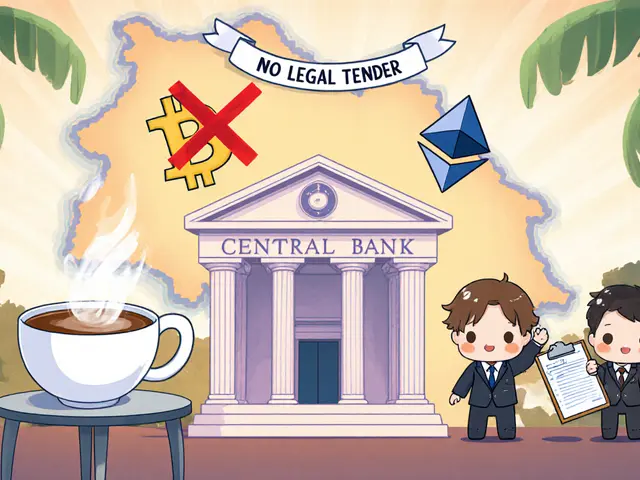Cryptocurrency Halving Tracker
Bittensor (TAO)
Dec 2025 - Feb 2026
Circulating Supply Triggered
Reward: Variable → 50% lower issuance
Ethereum Classic (ETC)
July 2026
Block Height: 25,000,001
Reward: 12 ETC → 6 ETC per block
Bitcoin (BTC)
April 2028
Block Height: ~1,050,000
Reward: 3.125 BTC → 1.5625 BTC
Halving Impact Calculator
Estimate how halvings may affect token supply and potential price appreciation.
Remaining Supply After Halvings:
Estimated Price Appreciation:
When it comes to cryptocurrency halvinga scheduled reduction in block rewards that cuts the flow of new tokens, the ripple effects can reshape entire markets. Investors, miners, and developers all watch the clock because a halving rewires supply, incentives, and sometimes even security.
Key Takeaways
- Three major halvings are slated between 2025‑2028: Bittensor (Dec2025‑Feb2026), Ethereum Classic (July2026), and Bitcoin (April2028).
- Historical data shows price appreciation typically peaks 6‑12 months after a halving, but macro‑economic trends may stretch that window.
- Reduced block rewards force miners to rely on higher token prices or transaction fees to stay profitable.
- Institutional accumulation-highlighted by ARKInvest’s recent $37.7M Bitcoin buy-can mute short‑term volatility around halving dates.
- Co‑occurring halvings could synchronize supply shocks, amplifying volatility across the broader crypto ecosystem.
What Is a Halving and Why It Matters
A halving is baked into the code of proof‑of‑work blockchains. When a pre‑defined block height is hit, the reward paid to miners instantly drops by 50%. This mechanism throttles inflation and ensures a finite supply.
For example, Bitcointhe original proof‑of‑work network started with a 50BTC reward in 2009 and will finish at 21million coins in 2140. Each halving reduces the block subsidy, pushing the network toward a fee‑driven security model.
Other blockchains adopt the same concept but tweak the parameters. Bittensora multi‑subnet AI‑focused network cuts its TAO issuance once the total circulating supply passes 10.5million, while Ethereum Classicthe proof‑of‑work fork of Ethereum will halve its block reward at block25,000,001.
Upcoming Halving Calendar (2025‑2028)
Understanding the timing helps traders align strategies with expected supply reductions.
| Blockchain | Halving Date (Estimated) | Block Height | Current Reward → New Reward |
|---|---|---|---|
| Bittensor (TAO) | Dec132025-Feb2026 | ~10,500,000 (circulating) | Variable → 50% lower issuance |
| Ethereum Classic | July23202610:01UTC | 25,000,001 | 12ETC → 6ETC |
| Bitcoin | April2028 (≈block1,050,000) | 1,050,000 | 3.125BTC → 1.5625BTC |
Deep Dive: Bittensor’s First Halving
Bittensor’s network is unique because it hosts dozens of subnets, each issuing its own “Alpha” token. The main TAO token serves as the base‑layer reward, and the halving will cut new TAO emissions in half once the circulating supply hits 10.5million.
The cut influences three moving parts:
- TAO Liquidity: With fewer fresh tokens, existing holders may see price pressure upward, but miners could also sell to cover operating costs.
- Alpha Dilution: Alpha tokens are pegged to TAO’s value through subnet‑specific staking. A sudden TAO scarcity could increase Alpha’s relative worth, reshaping incentives across subnets.
- Network Security: Lower rewards demand higher TAO prices for miners to stay break‑even, potentially increasing the cost of a 51% attack.
Because Bittensor’s halving depends on a circulating‑supply trigger rather than a block height, the exact date may shift as miners deregister, registration fees are paid, or cold‑key swaps occur.
Ethereum Classic’s Scheduled Cut
Ethereum Classic (ETC) maintains a pure proof‑of‑work model, making its halving more straightforward than Bittensor’s. The reward will drop from 12ETC to 6ETC per block on July232026.
Key implications:
- Mining Profitability: ETC’s hash‑rate has been volatile; a reward cut will pressure miners to either upgrade efficiency or rely on higher market prices.
- Fee Market Maturation: As block subsidies shrink, transaction fees will become a larger share of miner revenue, nudging the network toward a fee‑first security model.
- Strategic Positioning: ETC’s continued PoW stance differentiates it from Ethereum’s PoS, potentially attracting miners looking for “Bitcoin‑style” reward structures.

Bitcoin’s Fifth Halving: What to Expect
The Bitcoin community is already counting down to block1,050,000, expected around April2028. The block reward will fall from 3.125BTC to 1.5625BTC.
Historical patterns give us a rough playbook:
- Price usually stays flat or drifts modestly in the weeks surrounding the event.
- 6‑12 months later, the market often reacts with a strong up‑trend, as seen after the 2024 halving where Bitcoin surged to nearly $110k in January2025.
- Long‑term models, incorporating reduced supply and growing institutional demand, project $175k by the end of 2025 and $900k by 2030.
However, analysts now warn that macro‑economic headwinds-higher interest rates and longer‑term debt maturities-could push the next peak out to 2026 or later.
Macro Forces Shaping Halving Outcomes
Supply cuts are only one piece of the puzzle. The broader financial environment can amplify or mute their impact.
Institutional money is a growing force. ARK Investthe investment firm led by Cathie Wood recently bought $37.7million of Bitcoin, signalling confidence despite a possibly delayed price peak.
Data from CryptoQuanton‑chain analytics provider shows exchange reserves shrinking at an accelerating pace, a classic pre‑halving accumulation signal.
At the same time, global liquidity, measured by the M2 money supplya broad measure of cash, checking and savings deposits, has been expanding. Historically, spikes in M2 correlate with strong Bitcoin rallies, as more liquidity seeks higher‑yield assets.
All these forces interact. A halving that occurs during a period of abundant liquidity and strong institutional inflows can produce a “perfect storm” of price appreciation.
Mining Economics: From Block Rewards to Fees
Mining rewardsthe primary income source for PoW miners are the primary income source for PoW miners.
- When block subsidies shrink, miners need higher token prices to cover electricity and hardware costs.
- Eventually, once the supply cap is reached (Bitcoin in 2140), transaction fees will be the sole income source.
- Networks that can’t sustain fee revenue may see a drop in hash‑rate, potentially weakening security.
Understanding this transition helps assess long‑term network health, especially for newer chains like Bittensor that have complex incentive structures.
Potential Risks and Mitigation Strategies
While halvings can be bullish, they also introduce risks:
- Liquidity Crunch: A sudden cut in new tokens can create sell pressure if miners need cash. Staking or lock‑up mechanisms can ease this by reducing immediate market supply.
- Fee Volatility: As miners lean on fees, sudden spikes in transaction demand could make fee markets unstable, especially on networks with low throughput.
- Regulatory Changes: Governments may clamp down on mining energy use, which becomes more critical as miners chase higher price margins.
Investors can hedge by diversifying across assets with different halving schedules or by allocating a portion to fee‑capturing tokens such as LUNA or APT, which benefit from high transaction volumes.
Long‑Term Outlook: Synchronised Halvings, Amplified Effects
The 2025‑2028 window is unique. Three major supply‑reduction events will unfold within three years, potentially aligning market psychology. If Bitcoin’s price peaks in 2026, the preceding Bittensor and Ethereum Classic halvings could act as catalysts, feeding liquidity and sentiment into the biggest market.
On the flip side, if macro‑economic conditions sour-say, a global recession hits-investors may retreat to cash, muting the halving boost. The key takeaway is that halvings are no longer isolated; they now interact with institutional flows, macro data, and cross‑chain dynamics.
Take Action: How to Position for Upcoming Halvings
- Monitor on‑chain metrics: Watch exchange inflow/outflow data from CryptoQuant and miner hash‑rate trends.
- Allocate gradually: Dollar‑cost average into Bitcoin and ETC a few months before each halving to avoid buying at the peak.
- Consider fee‑generating assets: Networks like Bitcoin that are moving toward fee‑based security may reward holders of Lightning Network channels.
- Stay informed on Bittensor subnets: Follow Alpha token performance, as they may experience heightened volatility post‑TAO halving.
- Keep an eye on macro data: M2 growth, Fed rate decisions, and global debt maturity schedules can shift the timing of price peaks.

Frequently Asked Questions
When is Bitcoin’s next halving?
Bitcoin’s fifth halving is slated for around April2028, when block1,050,000 is expected to be mined. The block reward will drop from 3.125BTC to 1.5625BTC.
What makes Bittensor’s halving different from Bitcoin’s?
Bittensor’s halving is triggered by a circulating‑supply threshold (10.5million TAO) instead of a fixed block height. It also affects a multi‑subnet ecosystem where Alpha tokens rely on TAO liquidity.
How do halvings affect miner profitability?
When rewards halve, miners need a higher token price or lower operating costs to stay break‑even. Over time, transaction fees become an increasingly important income source.
Can institutional investors dampen halving‑driven rallies?
Yes. Large players like ARKInvest can accumulate steadily, reducing short‑term volatility. Their long‑term horizon may also shift market expectations, making price spikes less dramatic.
What macro factors could override a halving’s impact?
Global liquidity (M2 growth), interest‑rate policy, and major regulatory moves can dominate price dynamics, sometimes delaying or flattening halving‑related gains.
Understanding the timing, economics, and broader context of each upcoming cryptocurrency halving gives you a clearer edge. Whether you’re a miner, a trader, or a long‑term holder, the next three years will be a decisive period for supply‑driven price narratives.







Sidharth Praveen
November 6, 2024 AT 20:33Great rundown on the upcoming halvings! I think the market will reward patient holders, especially as Bitcoin edges closer to that 2028 cut. Keep an eye on institutional inflows – they tend to smooth out the volatility. Let’s stay optimistic and see how the supply shock plays out.
Sophie Sturdevant
November 7, 2024 AT 15:36Excellent analysis, but let’s add some depth: the hash‑rate dynamics post‑halving will dictate miner capitulation curves, while the issuance contraction boosts scarcity premium. You need to factor in macro‑policy drag and the fee market acceleration. Deploy your models now, the data’s screaming bullish.
Jan B.
November 8, 2024 AT 10:40The timeline is clear and the mechanics are well‑explained. Users should monitor on‑chain metrics to adjust exposure. Simplicity in presentation aids comprehension.
MARLIN RIVERA
November 9, 2024 AT 05:43This whole halving hype is just a distraction for the uninformed. Prices will stay flat until macro forces intervene. Anyone still buying on hope is delusional.
Debby Haime
November 10, 2024 AT 00:46Hey, don’t let the negativity bring you down! Every halving historically sparks fresh buying pressure, and the upcoming ones are no exception. Keep your focus on the long game and ride the wave.
emmanuel omari
November 10, 2024 AT 19:50From the perspective of someone who knows the inner workings of our national crypto policy, it’s obvious that these halving events will cement our regional dominance. The supply cuts align perfectly with our strategic goals.
Andy Cox
November 11, 2024 AT 14:53Looks like a solid breakdown of the events. Gotta say, the cross‑chain impact is fascinating – especially how Bittensor’s subnet dynamics could ripple across ecosystems.
Courtney Winq-Microblading
November 12, 2024 AT 09:56Contemplating the halving phenomenon feels like watching a cosmic tide recede, only to return more forceful. Each reduction in issuance is a reminder of scarcity’s quiet power over human greed. The dance between miner incentives and market psychology is poetically inevitable.
katie littlewood
November 13, 2024 AT 05:00Reading through this detailed tracker feels like opening a treasure map for the next three years of crypto adventures. The Bittensor schedule, with its circulating‑supply trigger, adds a layer of unpredictability that makes me eager to watch the subnet ecosystems evolve. Ethereum Classic’s straightforward block‑height halving reminds us that not all networks need exotic mechanisms to create scarcity; sometimes simplicity is the most elegant tool. Bitcoin’s fifth halving, slated for April 2028, continues the long‑standing tradition of supply tightening that has historically led to significant price appreciation, albeit with a lag that aligns with macro‑economic cycles. What strikes me most is the convergence of three major halvings within a relatively short window – a rare alignment that could catalyze cross‑asset flows, especially as institutional investors like ARK reinvest. The macro backdrop, with rising M2 liquidity and potential shifts in Fed policy, will likely amplify or dampen those effects, making it crucial for traders to monitor global liquidity metrics. Miners, too, will feel the squeeze: reduced block rewards push them toward higher transaction fees, nudging each network toward a fee‑first security model. As the halving events stack, we should also consider the risk of liquidity crunches; miners may be forced to sell, temporarily increasing market pressure. However, the growing adoption of staking and lock‑up mechanisms could mitigate those outs. From a strategic standpoint, diversifying exposure across assets with staggered halving dates-perhaps blending Bitcoin with Bittensor’s TAO and ETC-offers a hedge against timing risk while capturing upside. Finally, remembering that the crypto market is still nascent, these supply‑side shocks are powerful but not omnipotent; they interact with broader financial currents, regulatory developments, and technological advances. Staying informed, monitoring on‑chain data, and maintaining a flexible allocation strategy will be the keys to navigating the coming halving era successfully.
Jenae Lawler
November 14, 2024 AT 00:03While the preceding exposition is undeniably exhaustive, one must question the implicit assumption that halving events singularly dictate market trajectories. A discerning analyst recognizes that macro‑policy inflections and regulatory pronouncements often eclipse supply‑side mechanics. Consequently, the narrative presented, though erudite, borders on deterministic oversimplification.
Chad Fraser
November 14, 2024 AT 19:06Folks, keep the momentum! The next few halvings are perfect opportunities to double‑down on disciplined DCA. Let’s stay focused, share insights, and ride these supply shocks together.
Jayne McCann
November 15, 2024 AT 14:10Halvings won’t change anything.
Richard Herman
November 16, 2024 AT 09:13It’s worthwhile to view these events as a collective rhythm rather than isolated spikes. By aligning our strategies with the broader market cadence, we can foster stability and mutual benefit.
Parker Dixon
November 17, 2024 AT 04:16Pro tip: track miner hash‑rate and exchange inflow/outflow metrics 📊. When hash‑rate remains steady while inflows rise, it often precedes a bullish post‑halving run 🚀. Keep an eye on fee‑market health too – it’s the next revenue pillar for PoW chains.
Stefano Benny
November 17, 2024 AT 23:20All that data snooping won’t help if the macro environment stalls. Even with high hash‑rate, a tightening liquidity regime can smother any upward thrust. 💡
Bobby Ferew
November 18, 2024 AT 18:23Honestly, the whole halving discussion feels like a dramatized soap opera. Everyone acts as if the next block reward cut will magically solve every market woe, while ignoring the underlying pain points of mining economics and regulatory headwinds.
celester Johnson
November 19, 2024 AT 13:26One could argue that the melodrama surrounding halvings reflects a deeper human yearning for certainty in a stochastic universe. Yet, this yearning blinds us to the quiet truth: scarcity is merely a conduit, not a catalyst, for value creation.